›Office Riot‹
Drew Beattie & Ben Shepard works
Konstanz 20/01/2018—02/03/2018
Frankfurt 07/09/2018—09/11/2018
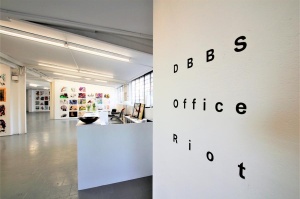

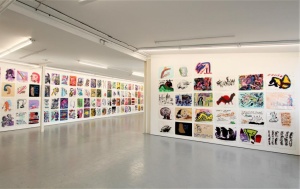
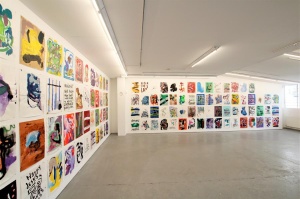
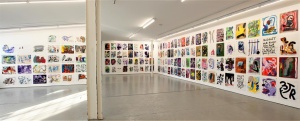
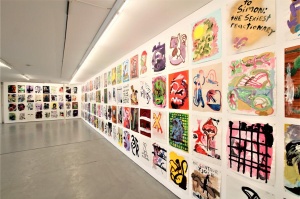
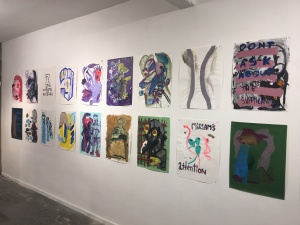

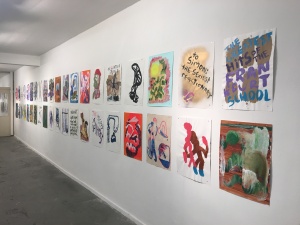
›Office Riot‹
Drew Beattie & Ben Shepard works
Konstanz 20/01/2018—02/03/2018
Frankfurt 07/09/2018—09/11/2018
Office ['äf-,'ôfis ], engl. für Büro, Arbeitszimmer, Schreibstube.
Riot ['rīƏt], engl. für Aufstand, Unruhe, Rebellion, Ausschreitung, Kuddelmuddel, Tohuwabohu.
Das Künstlerduo Drew Beattie und Ben Shepard lernte sich 2004 an der University of Chicago kennen. 2013 beschlossen sie ihre gemeinsame Zusammenarbeit, deren Ergebnisse zwei Jahre später zum ersten Mal unter dem Namen ›DBBS‹ ausgestellt wurden. Ben Shepard fasst dies zusammen mit den Worten ›The elective affinities worked out right, and we gave birth to a creative force. Call it DBBS.‹
We gave birth to a creative force. Call it DBBS.
Drew Beattie wurde 1952 in Atlanta, Georgia geboren, seine Werke befinden sich in zahlreichen internationalen Kunstmuseen. Seit den Siebzigerjahren lehrt er an einigen der besten Universitäten der Vereinigten Staaten, darunter Harvard, Berkley und der Universität von Kalifornien. Zuletzt ist er seit 2011 als „Distinguished Lecturer“ am Hunter College in New York tätig. Ben Shepard, Jahrgang 1984, studierte Philosophie an der University of Chicago. Er arbeitet zurzeit an verschiedenen interdisziplinären Projekten, so zum Beispiel an einer universitären Wohngemeinschaft, welche eine freie, fächerübergreifende Lehre vertritt. Er pendelt zwischen Shanghai und New York. Mehr als 250 Werke des Duos DBBS werden bei Lachenmann Art zu sehen sein. Auf Grund der Vielzahl der farbintensiven Acrylarbeiten verwandelt sich der Rundgang durch die Ausstellungsräume in ein nahezu überwältigendes Kunst-Erlebnis. Die Arbeiten der beiden Künstler werden bei Lachenmann Art exklusiv zum ersten Mal in Deutschland gezeigt. Die ausgestellten Werke besitzen alle dieselbe Abmessung (24 x 18 inch / 61 x 45,7 cm). Die meisten Arbeiten sind im Hochformat angelegt, einige wenige präsentieren sich als Querformat. Sie oszillieren inhaltlich bewusst zwischen Figuration und Abstraktion und nutzen ein breites Farbspektrum. Jede Arbeit ist in sich abgeschlossen und kann individuell betrachtet werden, die Wirkkraft multipliziert sich jedoch durch die außergewöhnliche Hängung und die beispiellose Anzahl der simultan präsentierten Papierarbeiten. Die impulsive Dynamik des Duos ist allgegenwärtig zu spüren. Die Blätter enthalten neben abstrakten und figürlichen auch literarische Elemente und behandeln politische, historische und philosophische Themen, sowie individuelle Erinnerungen der Künstler selbst.
A paper seems like a thought
Viele Künstler nutzen das Medium Papier als Trägermaterial für Vorskizzen. Für DBBS, die auch große Leinwandarbeiten erschaffen haben, ist die Wahl des Papiers als Untergrund eine bewusste Entscheidung, welche die Flüchtigkeit der Gedanken verkörpern soll, wie Drew Beattie im Gespräch erzählt: ›A paper seems like a thought‹. Eine Besonderheit stellt das gemeinsame Erschaffen der Werke, der tatsächliche Akt der Schöpfung der einzelnen Blätter in der Kollaboration der beiden Künstler dar. Während des Arbeitsprozesses befinden sich die Blätter in der Horizontalen, was den Künstlern den Blick aus der Vogelperspektive und somit einen ganzheitlichen Überblick ermöglicht. Ausgangspunkt für diesen Akt der Schöpfung ist der intensive gedankliche Austausch zu markanten Themen, die auch philosophisch hinterfragt werden. Daraufhin widmen sie sich intensiv der Analyse der Farbwahl und mischen durchschnittlich sieben bis zehn Farben pro Blatt vor, welche das Sujet der Arbeit unterstützen und eine individuelle Wirkkraft verleihen.
In der New Yorker Kunstszene gelten u.a. die deutschen Künstler Sigmar Polke (1941-2010) und Martin Kippenberger (1953-1997) als bedeutende Nachkriegskünstler mit großem Einfluss auf die danach folgende zeitgenössische amerikanische Kunst. Zahlreiche Versatzstücke und Anknüpfpunkte dieser sowie weiterer Künstler, wie zum Beispiel von Jonathan Meese (*1970), sind in den Werken des Duos DBBS als inspirativer Impuls zu finden.
The collaboration is like an umbrella of energy. –Drew Beattie
Aufgrund seiner Affinität zum Werk oben genannter deutschen Maler war in Drew Beattie bereits vor Jahren der Wunsch erwacht, in Deutschland eine Ausstellung zu realisieren. Wir lernten Drew während des Gallery Weekends 2016 in Berlin über Alexander Iskin kennen. Die Visionen dieses Großprojektes stimmten überein und nach mehrmonatiger Planung und Vorbereitung sind wir glücklich, diese außergewöhnliche Ausstellung ›Office Riot‹ nun endlich der Öffentlichkeit zugänglich machen zu können.
Lachenmann Art, Januar 2018
The artist duo Drew Beattie and Ben Shepard met at the University of Chicago in 2004. In 2013, they decided to work together and two years later, the results of this cooperation were exhibited for the first time under the name ›DBBS‹. Ben Shepard sums this up with the words ›The elective affinities worked out out right, and we gave birth to a creative force. Call it DBBS.‹
We gave birth to a creative force. Call it DBBS.
Drew Beattie was born in 1952 in Atlanta, Georgia, and his works can be found in numerous international art museums. Since the 1970s, he has taught at some of the best universities in the United States, including Harvard, Berkley and the University of California. Most recently, he has been Distinguished Lecturer at Hunter College in New York since 2011. Ben Shepard, born 1984, studied philosophy at the University of Chicago. He is currently working on various interdisciplinary projects, such as a university residential community which represents a free, interdisciplinary teaching programme. He oscillates between Shanghai and New York. More than 250 works of the duo DBBS will be shown at Lachenmann Art. Due to the large number of colour-intensive acrylic works, the tour of the exhibition rooms is transformed into an almost overwhelming art experience. The works of the two artists will be shown exclusively at Lachenmann Art for the first time in Germany. The exhibited works all have the same dimensions (24 x 18 inch / 61 x 45.7 cm). Most of the works are in portrait format, some of them are presented as landscape format. They deliberately oscillate between figurative and abstract content and use a broad spectrum of colours. Each work is self-contained and can be viewed individually, but the impact is multiplied by the extraordinary hanging and the unprecedented number of paper works presented simultaneously. The impulsive dynamics of the duo can be felt everywhere. In addition to abstract and figurative elements, the works also contain literary elements and deal with political, historical and philosophical themes, as well as individual memories of the artists themselves.
A paper seems like a thought.
Many artists use the medium paper as a base material for sketches. For DBBS, who have also created large canvas works, the choice of paper as a background is a conscious decision, which should embody the transience of thoughts, as Drew Beattie tells in conversation: ›A paper seems like a thought‹. A peculiarity is the joint creation of the works, the actual act of creation of the individual sheets in the collaboration of the two artists. During the working process, the sheets are placed horizontally, giving the artists a bird‘s-eye view and thus a holistic overview. The starting point for this act of creation is the intensive intellectual exchange on prominent themes, which are also questioned philosophically. As a result, they devote themselves intensively to the analysis of the colour selection and mix an average of 7 to 10 colours per sheet, which support the subject of the work and give it an individual impact.
In the New York art scene, the German artists Sigmar Polke (1941-2010) and Martin Kippenberger (1953-1997) are considered to be important post-war artists with great influence on contemporary American art. Numerous inspirational sources and connecting points of these and other artists, such as Jonathan Meese (*1970), can be found in the works of the duo DBBS as an inspirational impulse.
The collaboration is like an umbrella of energy. –Drew Beattie
Due to his affinity for the work of the above-mentioned German painters, Drew Beattie had already awakened a desire years ago to realise an exhibition in Germany. We met Drew during the Gallery Weekend 2016 in Berlin through Alexander Iskin. The visions of this major project matched and after planning and preparing for several months, we are happy to finally make this extraordinary exhibition ›Office Riot‹ accessible to the public.
Lachenmann Art, January 2018
Den Burger denken.
Es gibt viele Theorien und Ansätze, die erklären, was es bedeutet zu denken. Sie alle scheinen davon auszugehen, dass es Millionen von individuellen Einheiten gibt, von denen aus Gedanken ausgeführt werden. Sie sind sich allerdings über die Ursachen oder die spezifischen Orte, an denen die Gedanken aus dem Inneren dieser isolierten Wesen entspringen, nicht einig. Manche sprechen von neuronalen Netzwerken, andere beziehen sich auf eine unsterbliche Seele, die göttliche Inspiration erhält. Aber sie alle betrachten es als eine Handlung oder einen Prozess, der vom einsamen Denker durchgeführt wird, unabhängig davon, woher er kommt oder wohin er führt. Alleine, sogar wenn man an andere denkt. Das alles erscheint traurig, ungerecht und falsch.
Man braucht sich nur die Spanne der Zeichnungen anzusehen, die Drew Beattie und Ben Shepard geschaffen haben, um diese grausamen Vorstellungen abzulehnen und zu erkennen, dass das Denken tatsächlich ein Wesen ist. Ein Wesen, das das ganze Universum und die ganze Zeit umfasst, keinen physischen Körper hat und warm und einladend ist. Wir denken nicht, sondern treten in den Gedanken ein. Dieses Wesen bewegt sich durch uns, nährt und reproduziert sich aus unseren Handlungen, eine sich selbst replizierende Seins-Dimension. Es gibt viele Wege, um in den Gedanken einzutreten, aber wenn es um DBBS geht, beginnt deren Reise immer am Boden. Die Stimmung, in der der Gedanke sie dort findet, ist fröhlich, leicht und etwas beschleunigt (deshalb musste er sich eine Weile hinlegen). Die Künstler haben also ihren Boden, ihre einzelnen Papiere, die vereinbarten Farben und Pinsel, einige Füße, Staub und Schmutz, Feuchtigkeit. Jeder von ihnen fungiert als Stellvertreter für ein Körperorgan und zusammen bilden sie das Gesangssystem des Gedankens. An dieser Stelle hat der Gedanke keine Zeit für individuelle Konzepte oder nachvollziehbare Argumentationslinien. Wenn er spricht, besteht jeder Satz aus vier Aussagen, die gleichzeitig abgegeben werden, und sie alle widersprechen und untergraben sich gegenseitig, wie eifersüchtige Geschwister, die um Aufmerksamkeit kämpfen. Aber auch diese Aussagen lieben sich gegenseitig, also beginnen sie damit, die anderen zu verspotten und vergessen am Ende, welche sie sein sollten. Das Stimmsystem überarbeitet sich selbst, um diese Aussagen herauszugeben und mit den manischen Verlautbarungen des Gedankens Schritt zu halten.
Aber an welcher Stelle betreten Beattie und Shepard in diese Situation, fragen Sie sich? Der Schlüssel liegt im Double Cheeseburger. Die vier widersprüchlichen Aussagen sind wie der Kunde beim Drive-Thru, der nach seinem Burger fragt. Er beginnt mit der Bitte um einen normalen Burger, aber eigentlich würde er eine Limo bevorzugen, nein, eigentlich sollte der Burger aus Soda gemacht werden, und, warten Sie, wäre es nicht einfacher, wenn Sie einfach ein Objekt finden könnten, das alle Eigenschaften einer Cola und eines Burgers enthält, aber keins von beidem ist? DBBS sind die Kerle, die diesen Auftrag vorbereiten und ausliefern müssen. Was aus der Küche kommt, der Burger, wird durch die Zeichnungen repräsentiert. Aber der Burger ist nicht die Einzelzeichnung und es ist auch nicht die Verbindung von allen als Serie. Der Burger ist der Akt, vor den Zeichnungen zu stehen, alle ihre sich verändernden Qualitäten aufzunehmen und ein neues Alphabet zu schmieden, um sie zu benennen. Du wirst gefragt, ob Gott zurück ist, und du antwortest, indem du diese Befragung durch die Farbe Siena in eine anthropomorphe Pizzascheibe zwingst, die Moses mit dem göttlichen Türkisklumpen streichelt und verschmilzt. Das ist der Burger: Ihr Gefühl, das von der Frage angesprochen wird und das kurz und unbehaglich, aber nicht einsam auftaucht, denn selbst Ihr Schweigen ist eine Kommunikation im Inneren des Gedankens.
So sehen Sie, DBBS serviert den Burger und Sie sind drin, Sie sind dabei. Vielleicht sprechen wir deshalb von einem Doppelkäse-Burger? Die beiden Künstlerinnen produzieren nicht nur die Zeichnungen, sondern geben den Betrachtern auch eine neue Form, schmelzen und platzieren sie über das noch immer große und mutierende Irisieren, eine Decke aus schlaffen Hieroglyphen, die liebevoll darauf abgelegt sind.
— Sebastián González de Gortari
Thinking the burger.
Many are the theories and approaches to explain what it means to think. They all seem to posit that there are millions of individual entities from which thought is carried out. They may then disagree on the causes, or the specific locations it can spring from inside those isolated beings. Some speak of neuronal networks, others refer to an immortal soul that receives divine inspiration. But they all consider it an action or process enacted by the lonely thinker, regardless of where it came from or where it may take them to. Alone, even when thinking about others. This all seems sad, unfair and wrong.
One need only look at the span of drawings that Drew Beattie and Ben Shepard have created to reject these cruel notions and realize that thought is, in fact, a being. A being that spans the whole universe and all of time, has no physical body, and is warm and welcoming. We do not think, but rather, we enter Thought. This being moves through us, nourishes and reproduces itself from our actions, a self-replicating being-dimension. There are many paths to enter Thought, but when it comes to DBBS, their journey always starts at the ground. The mood in which Thought finds them there, is cheerful, light, and somewhat accelerated (that is why it had to lay down for a while) So, you have your ground, your individual pieces of paper, the agreed upon paints and brushes, some feet, dust and debris, humidity. Each of them functions as a stand-in for a bodily organ and together they comprise Thought´s vocal system. At this juncture Thought has no time for individual concepts, or traceable lines of argument. When it speaks, each sentence is composed of four statements issued simultaneously and they all contradict and undermine each other, like jealous siblings quarrelling for attention. But also, these statements love each other, so they start by mocking the others and end up forgetting which one they were supposed to be. The vocal system overworks itself in order to put out these statements and keep up with Thought’s manic proclaimations.
So where do Beattie and Shepard enter this situation you ask? The key lies in the Double Cheeseburger. The four contradictory statements are like the client at the drive-thru asking for his burger. He starts by requesting a normal burger, but, actually, he would prefer a soda, no, in fact the burger should be made out of soda, and, wait, wouldn't it just be easier if they could just find an object that contains all the properties of a cola and a burger but is neither of them? DBBS are the guys who must prepare and deliver that order/collapse-of-the-meaning-of-an-order. What comes out of the kitchen, the burger, represents the drawings. But the burger is not the individual drawings and it is also not the conjunction of all of them as a series. The burger is the act of being in front of the drawings, taking in all their shifting qualities and having to forge a new alphabet in order to name them. You are asked, if God is back and you reply by forcing that questioning burnt sienna into an anthropomorphic pizza slice Moses caressing/fusing with the divine turquoise lump. That is the burger: your feeling addressed by the question and coming up short and uneasy, yet not lonely, as even your silence is a communing inside Thought.
So, you see, DBBS serve the burger and you're in it, you are of it. Perhaps that is why we are talking of a double cheese burger? The two artists not only produce the drawings but also give new shape to, melt, the viewers and place them over the still-sizzling and mutating iridescences, a blanket of flaccid hieroglyphs placed lovingly on top.
— Sebastián González de Gortari
Lachenmann Art Konstanz
Brauneggerstraße 60
78462 Konstanz
+49 7531 369 1371
Öffnungszeiten
Mi — Fr 11 — 17 h
Sa 11 — 16 h
+ nach Vereinbarung
+49 69 7689 1811
Aktuell im Umzug | Currently in the process of relocating
